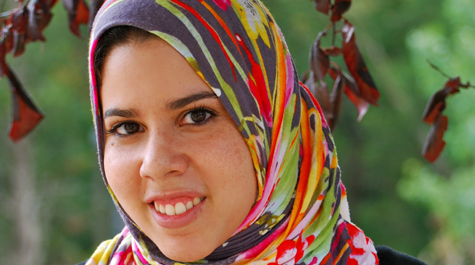Ibrahim '07: Being Muslim at the College and in America
For Ayah Ibrahim ’07, the transition from a large Muslim community in Northern Virginia to college at William & Mary was a phase of her life filled with anxiety and fear.
Ibrahim questioned whether she would be accepted in this new, unfamiliar environment. Would people understand the girl behind the hijab, wearing the traditional Muslim headscarf?
Her feeling of loneliness only intensified during the Islamic month of Ramadan, said Ibrahim, who was accustomed to gathering with family and friends to celebrate the month-long holiday. “It was literally like Thanksgiving every day at my house,” she described of her family’s Ramadan’s traditions.
“A William & Mary Ramadan,” authored by Ibrahim, is one of 40 personal essays shared in the anthology “I Speak for Myself: American Women on Being Muslim.” The book, written by American Muslim women under the age of 40 – all whom where born and raised in the U.S. – was recently named No. 2 on the Huffington Post’s top 11 religion books for 2011.
Muslims around the world fast from dawn to dusk and refrain from liquids as well as pleasures such as sex and smoking during Ramadan. The objective is to promote self-discipline, obedience to God, and awareness of basic human equality.
“On my first day of Ramadan, during my first year at college, I rose early and ate suhur (or the early morning meal) alone,” writes Ibrahim. “From suhur to iftaar (or breaking of the fast meal), I observed the holy month practically all by myself for the first year.
“My isolation left me conflicted. On one hand I felt closer to God because I believed I was overcoming the struggles of Ramadan by myself; however, on the other hand I felt that my spiritual knowledge was stagnant.”
Ibrahim candidly shares her first-year struggles in the essay, and expresses feelings of being disconnected from her family and the larger community.
“At college, there was no one around to remind me to pray. For the first time I didn’t have to answer to anyone but God,” Ibrahim recalls. She’s currently a Ph.D. student studying Comparative and American Politics at George Mason University.
Ibrahim soon became involved with William & Mary’s Muslim Students Association (MSA). She began outreach, connecting with other Muslim students on campus to forge a sense of community.
One incident Ibrahim shares with readers is when the all-male MSA officer entourage served deviled eggs, Twinkies and juice boxes after a day-long fast to students in the Arabic House.
“It was a truly unforgettable break-fast,” Ibrahim writes. “I didn’t expect a feast like I was accustomed to back home, but I definitely had no idea what we were in store for… Despite this, there was an overwhelming sense of gratitude in their efforts… It was a wonderful gesture and just what I needed to see to appreciate the generosity embodied by everyone during Ramadan.”
Luckily enough, Ibrahim and her friends were able to make a pit stop by the cafeteria once the “meal” was over.
As the MSA grew more active during Ibrahim’s junior and senior years, group suhurs and iftaars were held regularly during Ramadan. Late-night trips to IHOP and “before sunrise” wake-up calls were organized. The first potluck iftaar and suhur were held at the Arabic House, which included students of many ethnic and religious groups. An iftaar was arranged at a Muslim professor’s home –now a William & Mary tradition.
“My feeling of belonging only came to be when I was willing to accept that all I had been accustomed to was not the only way to observe Ramadan,” Ibrahim concludes. “With the William and Mary students, faculty and community as my new community away from home I felt blessed.”
Writers in “I Speak for Myself” explore a range of issues, from balancing Western and Islamic values, to wearing (or not wearing) the hijab in the workplace, to expressing their personal identities.
Ibrahim, who has worn the hijab since the age of 12, says she is aware of people’s reactions to her. She sees their expressions when she is wearing the headscarf.
“People react to me immediately and ask, ‘What country do you come from?’ And when I tell them that I’m actually born and raised in Virginia, I get a stunned look,” said Ibrahim. “I make it my challenge and my goal to dispel their preconceived notions or ideas about who I am and what I stand for.”
Ibrahim feels that telling her story is one way to correct the negative and false ideas about what it’s like to be Muslim in America. She also says the recent revolutions in the Arab world have changed people’s perceptions – at least a little.
“The reaction I get from people now is ‘Wow, they like democracy’ – or, ‘They actually like freedom?’ And ‘We actually saw women on the street for the first time’ ” – all recent conversations Ibrahim has logged in her memory bank.
Ibrahim says there’s also the conflicting balance of being labeled as too Muslim or too American. For women like Ibrahim who wear the headscarf, “I don’t appear to be American enough, just based on my appearance because I choose to wear my religion on my head,” she said.
But that’s okay, she says. She can speak for herself.
 Skip to main content
Skip to main content

